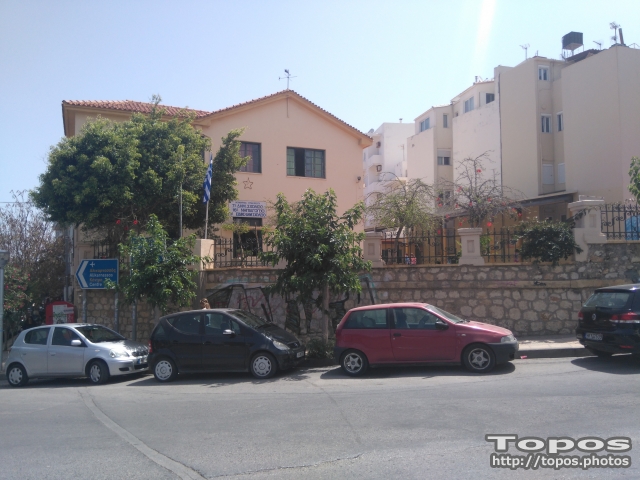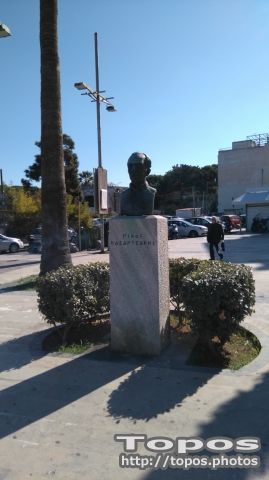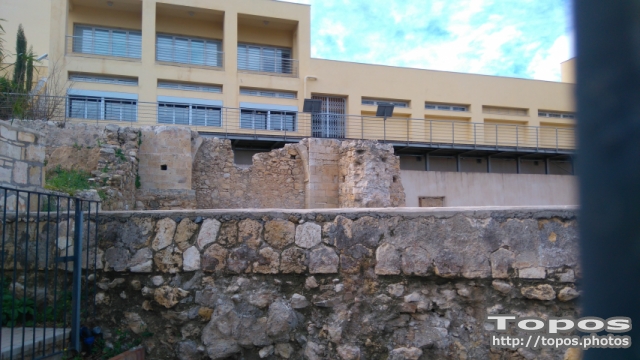Press here.

Places near 39ο ΔΗΜΟΤΙΚΟ ΣΧΟΛΕΙΟ ΗΡΑΚΛΕΙΟΥ
The prefecture of Heraklion is the largest in area, lies between the prefectures of Rethymnon and Lassithi, has the greatest population and the highest per capita income of Crete. Its capital is also Heraklion and the biggest town of Crete. It has approximately 150,000 inhabitants. It concentrates the biggest economical activity of the island and attracts many tourists every year. There are so many sites which worth visiting that you can't decide where to go first. Heraklion is inhabited since antiquity. The ancient towns of Knossos, Phaestos, Malia etc. will bring you to the Minoan era. The Venetian monuments spread all over the town give Heraklion a charming image. Should you come to Heraklion, you mustn't miss visiting the archaeological museum. Heraklion is a very active city, where you can enjoy anything which comes into your mind. The best night life, cinemas, restaurants, luxury hotels, bungalows and anything that you will need to have wonderful vacations. There are seven provinces in this prefecture: Malevizi, Temenos, and Pediada on the north coast and Pirgiotisa, Kainourio, Monofatsi, and Viannos in the centre and on the south coast. The main cities are Timbaki, Ano Viannos, Matala, and Mires. The northwestern area of the prefecture of Heraklion is comprised of the three provinces of Malevizi, Temenos, and Pediada. The main city is Heraklion. This area is the largest of grape - producing areas of Crete and its main products are sultana raisins, Malevizi (Malmsey) wine, and table grapes (Rosaki). In these valleys Sir Arthur Evans, the British archaeologist, excavated the Minoan Palace of Knossos, the remains of a great civilization. A low mountain range rises in the middle of the prefecture and descends into the Messara Plain. These fertile plains have been cultivated for thousands of years and have important Minoan, Greek, and Roman archaeological sites -- Festos, Agia Triada, and Gortys are the major ones. The imposing peak of Psiloritis, 2,456 metres above sea level, is visible from almost all points of the prefecture of Heraklion. It is especially impressive during the winter months when it is snow-capped. The prefecture of Heraklion has many cultural and historical features to offer the visitor. The finest collection of Minoan artefacts in the world and the sites of one of history's greatest civilizations may be of interest as well as the numerous Byzantine churches and Venetian castles and fountains. The historical aspects combine with the scenic landscapes of mountains, valleys, and sea to make this a beautiful and fascinating area. The beaches of Agia Pelagia and Limin Hersonisou (also known as just Hersonissos) on the north coast and Matala and Kali Limenes on the south coast will attract the visitor with their warm, clear seas. There are many fine restaurants and tavernas offering Cretan specialities throughout the area. The eastern part of the Heraklion prefecture has some major tourist resorts near the sea (Limin Hersonisou), some major archaeological sites (Malia), and many important Byzantine churches. The southern area of the prefecture of Heraklion includes the four provinces of Pirgiotisa, Kainourio, Monofatsi, and Viannos. The most prominent physical feature here is the Pediada Messaras. It stretches east from Timbaki to Ano Viannos. The plain is between the low mountain ranges of the south and north. The main products of Messara are cereals, olives, and fruits. and cultivation goes on year-round, aided by the use of hothouses to increase productivity. If you love nature and sea, there are so many beaches in the north and south of the prefecture that will surely cast a spell on you. The plains of Messara give you the opportunity to enjoy the view of numerous fruit trees of all varieties and smell the air of unique natural environment.
The church of Saint Titus (First Bishop of Crete) is one of the most interesting religious monuments in the centre of the city. The Skull of the Apostle Saint Titus is kept at the church.
During the 2nd Byzantine period, the church, which was the most official and larger in Chandax, became the cathedral of the new Cretan Diocese. The Venetians later converted it into the Catholic Diosese. During the Ottoman rule, it was converted into a mosque (Vizier mosque) and the bell tower into a minaret. The church has suffered repeated destructions by earthquakes and fires. Nevertheless, conquerors of each period ensured its immediate restoration, since it was the city's most significant religious monument. In 1925 following the population exchange the church came within the juristiction of the Church of Crete.
Jesus Gate (also known as the new Gate) was one of the central gates of Chandax during the Venetian period. It led to the southern provinces and that is also whera thw south road axis of the city ended, the Evans Street of today.
The gate, work of Michele Sanmicheli, is one of the finest examples of Renaissance architecture in the city and is particularliy distinguished for its monumental facade. On each side of the main gate are other openings that correspond to windows and secondary entrances to auxiliary areas within the arcade and that served as ammunition warehouses and a station area for the guards. The place is reconstructed and specially designed to operate as a museum dedicated to the life and works of the great writer Nikos Kazantzakis.
With the appearance of cars in the early 20th century, an opening to the fortification was made to the east of Jesus Gate known as the New Gate, which was bridged over in 1970.
St. George gate is the gate that once connected the Venetian town of Chandaka to eastern Crete. The gate is located to the east of Eleftherias Square just below the statue of Eleftherios Venizelos.
According to an inscription, the gate is built in 1565. Its name comes from a relief decorative representation of St. George, which is today exhibited in the historical museum of the city. The gate was formerly known as Lazareto, because it led to the homonymous sanctuary, and later as Maroulas gate leading to the homonymous district.
A 43 meter-long gallery begins through the gate, which can be visited and usually hosts exhibitions, which ends at the east of Eleftherias Square.
The Museum of the Battle of Crete and National Resistance (1941-1945) was founded by the Municipality of Heraklion in May 1994.






















